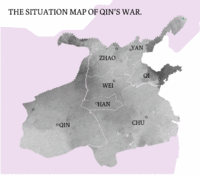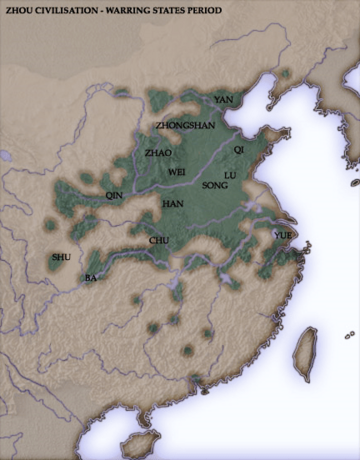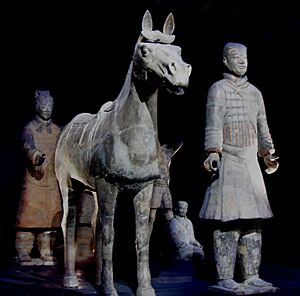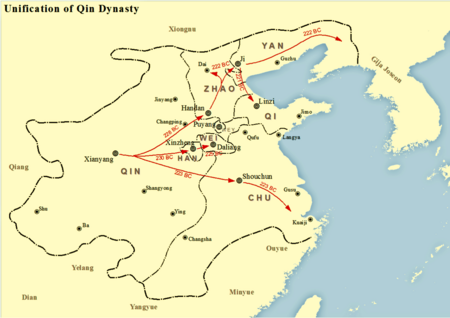Qin's wars of unification facts for kids
Quick facts for kids Qin's wars of unification |
|||||||||
|---|---|---|---|---|---|---|---|---|---|
| Part of the Warring States period | |||||||||
 Date of conquest of the six states |
|||||||||
|
|||||||||
| Belligerents | |||||||||
| Qin | |||||||||
| Commanders and leaders | |||||||||
|
|
||||||||
| Strength | |||||||||
| 1,200,000 | 1,500,000 | ||||||||
The Qin's wars of unification were a series of big military fights. They happened in ancient China during the late 200s BC. The state of Qin fought against six other powerful states: Han, Zhao, Yan, Wei, Chu, and Qi.
From 247 BC to 221 BC, Qin grew into one of the strongest states in China. This was after the Zhou dynasty became very weak. In 230 BC, King Ying Zheng of Qin started his plan to conquer all the other states one by one. This brought the Warring States period to an end.
By 221 BC, Qin had won, and China was united under Qin's rule. Ying Zheng then called himself the First Emperor, or Qin Shi Huang. He was the first ruler of a united China under the Qin dynasty.
Contents
How Qin Became Powerful

Qin's Rise and Early Wins
During the Warring States period, the state of Qin became very strong. This was especially true after Shang Yang made important changes to its government in the mid-300s BC. The other six states often tried to team up against Qin. They called this a "vertical alliance."
But Qin was smart. It sometimes made its own deals with some of these states. These were called "horizontal alliances." This way, Qin could turn its enemies against each other.
In 316 BC, Qin expanded south into the Sichuan Basin. It conquered the states of Ba and Shu. In 278 BC, Qin, led by General Bai Qi, attacked Chu. They took over land in what is now Sichuan. Qin captured Chu's main cities, Ying and Chen. Chu lost all its land west of the Han River. In 272 BC, Qin conquered the Xirong state of Yiqu.
After the last horizontal alliance against Qi ended in 284 BC, Qin fought many wars against the northern state of Zhao. These battles happened in 283, 269, and 265 BC.
In 269 BC, Fan Sui became a top advisor to Qin. He believed Qin should always expand and make alliances with far-off states to attack closer ones. In 265 BC, King Zhaoxiang of Qin attacked the Shangdang region of Han state. The governor of Shangdang refused to give up and instead gave the land to Zhao. Qin and Zhao armies then faced off in a long siege at Changping. This battle lasted two years and ended with a big defeat for Zhao.
In 257 BC, the Qin army tried to capture Zhao's capital, Handan. But the combined forces of Zhao, Wei, and Chu defeated Qin.
At this time, the kings of the Zhou dynasty had almost no power left. Their land was split into two small states: West Zhou and East Zhou. Qin forces conquered West Zhou in 256 BC. They took the Nine Cauldrons, which were symbols of power. This made Qin seem like the true ruler of China. In 249 BC, the new Qin king, Zhuangxiang, conquered East Zhou. This ended the Zhou dynasty, which had lasted for over 800 years.
King Ying Zheng's Plan
In 238 BC, King Ying Zheng of Qin took full control. He removed his rivals, Lü Buwei and Lao Ai. With help from advisors like Li Si and Wei Liao, Ying Zheng made a plan. His goal was to conquer the other six major states and unite China.
His plan was based on a strategy called "allying with distant states and attacking nearby ones." The main steps were:
Unification Battles
Taking Over Zhao
From 283 BC to 257 BC, Qin and Zhao fought many bloody wars. Zhao's big loss in the Battle of Changping in 260 BC made them much weaker.
In 236 BC, Zhao was attacking Yan. Qin used this chance to send two armies to invade Zhao. One Qin army, led by Wang Jian, took over Zhao's lands of Eyu and Liaoyang. Another Qin army, led by Huan Yi, Qiang Lei, and Yang Duanhe, captured Ye and Anyang. Zhao lost nine cities, and its army became even weaker.
Two years later, Qin wanted to attack Han. But they worried Zhao might help Han. So, Qin general Huan Yi led an army to attack Zhao's lands of Pingyang and Wucheng. Over 100,000 soldiers died in this battle. The Zhao army was defeated, and its commander, Hu Zhe, was killed. In 233 BC, Huan Yi's army crossed Mount Taihang. They conquered Zhao territories of Chili and Yi'an. Then, the Qin army under Huan Yi fought the Zhao army led by General Li Mu at the Battle of Fei. Qin suffered a huge defeat and lost almost all its soldiers.
In 232 BC, Qin forces captured Langmeng. Soon after, they attacked Fanwu but were again defeated by Li Mu's Zhao army. However, after this battle, Zhao also had heavy losses. They had to retreat to defend Handan and its nearby areas.
In the next two years, Zhao faced two natural disasters: an earthquake and a severe famine. In 229 BC, Qin took advantage of this. They launched a two-sided attack on Handan, Zhao's capital. Three Qin armies attacked from different directions. Meanwhile, Qin general Li Xin led two forces to attack Dai County in the north. On Zhao's side, Li Mu and Sima Shang led the army. Li Mu told his troops to build defenses and avoid direct fighting. The Qin forces couldn't advance, and both sides were stuck.
The Qin state then bribed Guo Kai, a Zhao minister. Guo Kai made King Qian of Zhao doubt Li Mu's loyalty. The king ordered Li Mu to give up his command. When Li Mu refused, the king became more suspicious. He ordered his men to arrest Li Mu by surprise. Li Mu was later killed in prison on the king's order.
In 228 BC, Qin forces learned that Li Mu had been replaced. They attacked, defeated the Zhao army, and conquered Dongyang. Zhao Cong was killed, and Yan Ju escaped. Seven months later, Qin forces took Handan and captured King Qian. This ended the state of Zhao.
Prince Jia, King Qian's brother, escaped from Handan. He went to Dai. With help from some remaining Zhao people, he declared himself the King of Dai. In 222 BC, Dai was conquered by the Qin army led by Wang Jian's son, Wang Ben. Prince Jia was captured.
| Year | Event |
|---|---|
| 230 BC |
|
| 228 BC |
|
| 225 BC |
|
| 223 BC |
|
| 222 BC |
|
| 221 BC |
|
Taking Over Han
Han was the weakest of the seven states. Qin had attacked it many times before. In 230 BC, the Qin army, led by Neishi Teng, moved south. They crossed the Yellow River and conquered Zheng, Han's capital, in one year. King An of Han gave up, and Han became part of Qin. Han's land was then made into Qin's Yingchuan Commandery.
Taking Over Yan
In 228 BC, after Zhao fell, Wang Jian prepared the Qin army to attack Yan. Ju Wu, a Yan minister, suggested to King Xi of Yan that they should team up with Dai, Qi, and Chu. He also suggested making peace with the Xiongnu in the north to fight Qin.
However, Crown Prince Dan thought this plan wouldn't work. So, he sent an assassin named Jing Ke to kill King Ying Zheng of Qin. Jing Ke pretended to be a messenger from Yan. He brought a map of Dukang and the head of Fan Wuji, a former Qin general who had turned against Qin. Jing Ke failed to kill Ying Zheng and died in the attempt.
In 226 BC, Ying Zheng used this assassination attempt as a reason to attack. He ordered Wang Jian and Meng Wu to lead the Qin army against Yan. The Qin forces defeated the Yan army and its helpers from Dai. They then captured Ji, the Yan capital. King Xi of Yan, Crown Prince Dan, and the remaining Yan forces fled to the Liaodong Peninsula. A Qin army, led by Li Xin, chased them and destroyed most of the Yan army. Later, King Xi ordered Crown Prince Dan to be killed. He sent his son's head to Qin as an "apology." Qin accepted and did not attack Yan for the next three years.
In 222 BC, Qin forces, led by Wang Ben and Li Xin, invaded the Liaodong Peninsula. They destroyed the rest of the Yan forces and captured King Xi. The former Yan lands were divided into several Qin commanderies.
Taking Over Wei
In 225 BC, a huge Qin army of 600,000 soldiers, led by Wang Ben, attacked Chu's northern border. This was to protect Qin's side while they invaded Wei. Wang Ben then led his forces north to attack Daliang, the Wei capital. Daliang was hard to attack because it was surrounded by rivers and a canal. It also had a wide moat and strong gates. The Wei troops made their defenses even stronger.
Wang Ben came up with a plan to flood Daliang. His troops worked for three months to change the flow of the Yellow River and the Hong Canal. They succeeded, and Daliang was heavily flooded. Over 100,000 people died, including civilians. King Jia of Wei gave up, and Wei became part of Qin. Qin then set up new regions in the former Wei lands.
Taking Over Chu
In 226 BC, Qin forces led by Wang Ben attacked Chu and took 10 Chu cities. Two years later, King Ying Zheng of Qin met with his advisors to discuss invading Chu. Wang Jian thought they needed at least 600,000 soldiers. But Li Xin said 200,000 would be enough. Ying Zheng chose Li Xin's idea and ordered Li Xin and Meng Tian to lead a 200,000-strong army to attack Chu. Wang Jian said he was sick and went home to rest.
The Qin armies won some early battles. Li Xin's army conquered Pingyu, and Meng Tian's captured Qinqiu. After taking Yan, Li Xin headed west to meet Meng Tian at Chengfu.
On Chu's side, General Xiang Yan avoided using most of his army. He waited for a chance to counterattack. During this time, a Qin noble named Lord Changping, who was related to the Chu royal family, started a rebellion in a city Qin had taken. Changping also planned a surprise attack on Li Xin. The Chu army, led by Xiang Yan, secretly followed Li Xin's army for three days and nights. Then, they launched a surprise attack. Lord Changping's forces joined Xiang Yan's army in attacking Li Xin. Most of Li Xin's soldiers were destroyed.
When Ying Zheng heard about Li Xin's defeat, he personally visited Wang Jian, who was retired. He apologized for not listening to Wang Jian earlier. He asked Wang Jian to come back to the army. He put Wang Jian in charge of the 600,000 troops he had asked for. Meng Wu was assigned as Wang Jian's second-in-command. Wang Jian knew Ying Zheng didn't fully trust him with such a large army. So, to ease the king's worries, he often sent messengers to the king. He also asked the king to reward his family after he conquered Chu.
In 224 BC, Wang Jian's army marched through Chen and set up camp at Pingyu. The Chu army, led by Xiang Yan, attacked the Qin camp but couldn't push them back. When the Chu army tried to trick Qin into attacking them, Wang Jian ordered his troops to stay in their positions. After some time, Xiang Yan gave up and ordered the Chu army to retreat. Wang Jian then quickly ordered his troops to attack while the Chu army was retreating. This caught them by surprise and scattered them. The Qin forces chased the retreating Chu forces to Qinan and defeated them. Xiang Yan was killed.
In 223 BC, Qin forces captured Shouchun, the Chu capital. Lord Changping, the King of Chu, was killed by Meng Wu. Chu was completely taken over by Qin. The next year, Wang Jian and Meng Wu led the Qin army to attack the Wuyue region (present-day Zhejiang and Jiangsu). They captured the descendants of the ancient state of Yue's royal family. The conquered Wuyue lands became Qin's Kuaiji Commandery.
Taking Over Qi
In 264 BC, Tian Jian became King of Qi. But he was too young to rule, so his mother, the Queen Dowager, ruled for him. The Qin state bribed Hou Sheng, Qi's chancellor. Hou Sheng convinced Qi not to help the other states when Qin attacked them. By 221 BC, Qi was the only state left for Qin to conquer. Even though its soldiers were not well-equipped and their spirits were low, Qi quickly sent them to the western border to guard against a Qin invasion.
In the same year, Ying Zheng used Qi's refusal to meet with a Qin messenger as an excuse to attack. The Qin army, led by Li Xin, avoided fighting the Qi forces on their western border. Instead, they went around through the former Yan state and entered Qi from the south. The Qin forces met little resistance as they moved through Qi lands. They eventually arrived at the gates of Linzi, the Qi capital. Caught off guard, Tian Jian listened to Hou Sheng's advice and surrendered to Qin without a fight. The former Qi lands were divided into Qin's Qi and Langya commanderries.
Aftermath
In 221 BC, after conquering Qi, Ying Zheng declared himself Qin Shi Huang. This meant "First Emperor of the Qin dynasty". The Qin Empire was divided into 36 regions called commanderries. Xianyang (present-day Xi'an) became the capital city.
The emperor's plans for expansion didn't stop after uniting China. In 215 BC, he ordered Meng Tian to lead over 300,000 soldiers. Their mission was to push back the Xiongnu, a nomadic group who had been moving into Chinese territory. After a big win against the Xiongnu, Qin forces built and strengthened a huge wall. This became the Great Wall of China. It stretched from the Liaodong Peninsula in the east to Lop Nur in the west. This wall was meant to stop the nomadic tribes from coming back.
In the south, a Qin army of about 500,000 soldiers attacked Yue. They brought the Baiyue peoples under control. These people lived in areas that are now Jiangsu, Zhejiang, Fujian, and Guangdong. During this battle, a huge canal was built. It connected the Qin capital, Xianyang, to the Yue state. This canal was key to Qin's victory in the south. The Yue state became a part of the Qin Empire for over ten years.
After these two victories, Qin Shi Huang created a strong, central empire. This empire would become the foundation for future Chinese dynasties. Even though the Qin dynasty only lasted 15 years, its impact on Chinese history lasted for centuries.
In 209 BC, during the rule of Qin Er Shi, Chen Sheng and Wu Guang started an uprising. They wanted to overthrow the Qin dynasty because of its harsh rules. Even though this revolt was crushed, other rebellions broke out across the Qin Empire over the next three years.
Ziying of Qin was the third and last Qin emperor. He surrendered to a rebel force led by Liu Bang in 206 BC. This ended the Qin dynasty. Some of the winning rebels claimed they were bringing back the old states Qin had conquered. Many people tried to become kings of these old states. That same year, the city of Xianyang was attacked by Xiang Yu's forces. Xiang Yu was a descendant of the Chu general Xiang Yan. Xiang Yu and Liu Bang then fought for control of China in a conflict called the Chu–Han Contention. Liu Bang won in 202 BC. He then started the Han dynasty, which took over and built upon much of what Qin had created.



